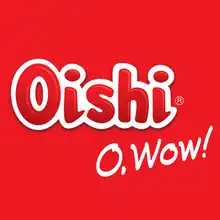Oishi (Philippine brand)
Liwayway Holdings Company Limited, doing business as Oishi (/oʊˈwɪʃiː/ OH-wih-SHEE), is a snack company based in the Philippines.[1] Its headquarters are in Pasay in Metro Manila.[2] As of 2018, it is headed by Carlos Chan.[3] In China, the company is known as Oishi Shanghaojia (上好佳OISHI).[4]
 | |
| Type | Private |
|---|---|
| Industry | Food and beverage industry |
| Founded | 1946 |
| Headquarters | Pasay, Philippines Imus, Cavite |
Area served | Southeast Asia, China, South Asia and South Africa |
Key people | Carlos Chan (Chairman and CEO) |
| Products | Snacks, cereals, biscuits, milk and beverages |
| Website | www |
History
Oishi, started in 1946 as Liwayway,[5] was originally a family-owned corn starch (Tagalog: gawgaw) and coffee repacking business.[1] The name of the business, "Liwayway," meaning "dawn" in English, was selected to reflect the optimism of the Philippines following the aftermath of World War II.[5] By 1966, in addition to distributing starch, the company also began to distribute basic commodities, coffee, and confectioneries. It was incorporated under the name Liwayway Marketing Corporation (LMC) in 1966.[1]
Brothers Carlos and Manuel Chan, at the time, were behind the company.[1] Their brother Ben is the founder of Bench, a Philippine clothing brand.[6] The parents of the Chan brothers are immigrants to the Philippines from Jinjiang county, Quanzhou, Fujian Province, China.[4][7]
The company began distributing Oishi Prawn Crackers and Kirei Yummy Flakes in 1974. The company claims to have been implementing technology from Japan to make the products.[5]
Expansion
Carlos Chan began prospecting on the expansion of Oishi to China in 1984, following the liberalization of the Chinese economy under Deng Xiaoping starting in 1978.[8] Liwayway went under the name Oishi Shanghaojia, appending "Shanghaojia" (上好佳) to Oishi which literally means "top grade and high quality" in Chinese, and a pun for "尚好甲" (shiang ho jiak, "most tasty") in Hokkien. It entered a joint venture with two state-owned Chinese firms and opened its first overseas manufacturing plant in Pudong, Shanghai[4] The company's China division set up its headquarters in Qingpu District, Shanghai.[9] To improve distribution in China, the company established a factory network there.[3] Oishi also established a presence in Vietnam in 1997 and in Myanmar in 1999. In 2006, factories were opened in Indonesia and Thailand.[8]
Interlink Direct Ltd. imports Oishi products from China to the United Kingdom.[10]
Reception
In 1998, for his contributions to Shanghai, Carlos Chan received a "Magnolia Gold Award," a prize that recognizes expats who contribute to Shanghai's development.[4] In 2005, the City of Shanghai made Carlos Chan an honorary citizen, and Oishi Shanghaojia was declared a "Shanghai famous brand" the following year.[4]
References
- "Overview." Oishi China. January 3, 2013. Retrieved on April 4, 2014.
- "Privacy Policy Archived 2014-04-07 at the Wayback Machine." Oishi. Retrieved on April 5, 2014. "Liwayway Marketing Corporation 2225 Tolentino St. Brgy. 129, Pasay City"
- Flannery, Russell. "He's Not Japanese: China Success Helps Oishi's Carlos Chan Debut On New Philippines List." Forbes. August 11, 2013. Retrieved on April 4, 2014.
- Wu, Willa (28 Sep 2018). "Chinese miracle beckons for Filipino 'snacks king'". China Daily. China Daily Information Co (CDIC). Retrieved 14 November 2018.
- "History." Oishi. Retrieved on April 4, 2014.
- Landingin, Roel (2 Dec 2015). "Made It In China: Liwayway's Group Is Now A Leading Brand". Forbes. Forbes Media LLC. Retrieved 14 November 2018.
- Zafra, Jessica. "Carlos Chan: Mr. Oishi." The Philippine Star. March 18, 2012. Retrieved on April 5, 2014.
- Dy, Rolando (26 January 2015). "Building a multinational brand: The Oishi story". Philippine Daily Inquirer. Retrieved 22 September 2016.
- "Company Overview of Liwayway Holdings Company Limited." Businessweek. Retrieved on April 5, 2014. "2277 Hu Qing Ping Highway Shanghai, 201702 China"
- "Oishi 上好佳 Archived 2014-04-07 at the Wayback Machine." Interlink. Retrieved on April 5, 2014.
External links
- Oishi
- Oishi China
- Oishi China (oishi-tm.com) (Archive)
- San Juan, Thelma Sioson. "The Pinoy chips that conquered China." Philippine Daily Inquirer. Sunday March 18, 2012.